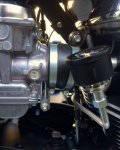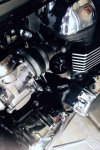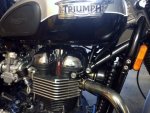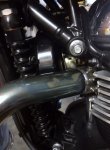Dsinned
Scooter
I hooked up a low cost OBD2 BT dongle to my OBD2 (ECU) port so I can monitor many more engine parameters from my 7" Android tablet via an app like TORQUE PRO or DashCommand; I also use OBDLink because I'm using an OBD2 BT dongle sold by the same company.
I have the dongle semi-permanently connected under the seat. It is the type that has an automatic "sleep mode" so as not to inadvertently drain a 12V battery if left connected all the time. When I restart the engine the dongle "wakes up" and re-pairs automatically to the BT in my tablet. This is convenient so I don't have to ever remove the seat before a ride.
I have my tablet bungee cord strapped over my bike's instrument gauges, so I can monitor engine parameters of any interest while riding. This works well at night, but not so much during daylight due to reflected sunlight washing out the tablet's LCD display even with the brightness increased to maximum.
I have the Android OBD2 app setup to continuously monitor and display engine oil temp, in degrees F (fahrenheit) on a virtual analog gauge built-in the app.
Btw, this technique does a great job of indicating instanteous and average "MPG" while riding. Other parameters of interest are fuel rate, TPS, MAP, MAF, timing advance, calculated engine load, 12V battery voltage, and of course engine rpm and vehicle speed.
While just taking a ride within the city limits with speed limit of 35, I noticed the oil temp slowly rising to 220F. This was the high point just before I turned off the engine and parked the bike in my garage after a ride of about 15 minutes. I'm not sure if that was the "peak", or if it would of increased even higher. Of course, without any air flow thru the oil cooler, while warming up the engine and/or at a stop light, it probably would have.
It was only in the low 70 degrees F this afternoon during my ride, almost a perfect day for a leisurely ride of only a few miles.
Does anybody know what operating temperature the oil cooler thermostat kicks in? Is there internal oil flow thru the cooler at all times while the engine is operating?
From my observation, it must peak at 220F or higher, which seems a bit high to me with some amount of outside air flowing thru the cooler.
It seems to me the one "design weakness" of the 865cc Bonneville engine is that it does not have a forced air cooling fan mounted behind the oil cooler. If it did, it could be thermostatically controlled to help keep the engine oil from over heating under worse case operating conditions.
Comments?
I have the dongle semi-permanently connected under the seat. It is the type that has an automatic "sleep mode" so as not to inadvertently drain a 12V battery if left connected all the time. When I restart the engine the dongle "wakes up" and re-pairs automatically to the BT in my tablet. This is convenient so I don't have to ever remove the seat before a ride.
I have my tablet bungee cord strapped over my bike's instrument gauges, so I can monitor engine parameters of any interest while riding. This works well at night, but not so much during daylight due to reflected sunlight washing out the tablet's LCD display even with the brightness increased to maximum.
I have the Android OBD2 app setup to continuously monitor and display engine oil temp, in degrees F (fahrenheit) on a virtual analog gauge built-in the app.
Btw, this technique does a great job of indicating instanteous and average "MPG" while riding. Other parameters of interest are fuel rate, TPS, MAP, MAF, timing advance, calculated engine load, 12V battery voltage, and of course engine rpm and vehicle speed.
While just taking a ride within the city limits with speed limit of 35, I noticed the oil temp slowly rising to 220F. This was the high point just before I turned off the engine and parked the bike in my garage after a ride of about 15 minutes. I'm not sure if that was the "peak", or if it would of increased even higher. Of course, without any air flow thru the oil cooler, while warming up the engine and/or at a stop light, it probably would have.
It was only in the low 70 degrees F this afternoon during my ride, almost a perfect day for a leisurely ride of only a few miles.
Does anybody know what operating temperature the oil cooler thermostat kicks in? Is there internal oil flow thru the cooler at all times while the engine is operating?
From my observation, it must peak at 220F or higher, which seems a bit high to me with some amount of outside air flowing thru the cooler.
It seems to me the one "design weakness" of the 865cc Bonneville engine is that it does not have a forced air cooling fan mounted behind the oil cooler. If it did, it could be thermostatically controlled to help keep the engine oil from over heating under worse case operating conditions.
Comments?
Last edited:









